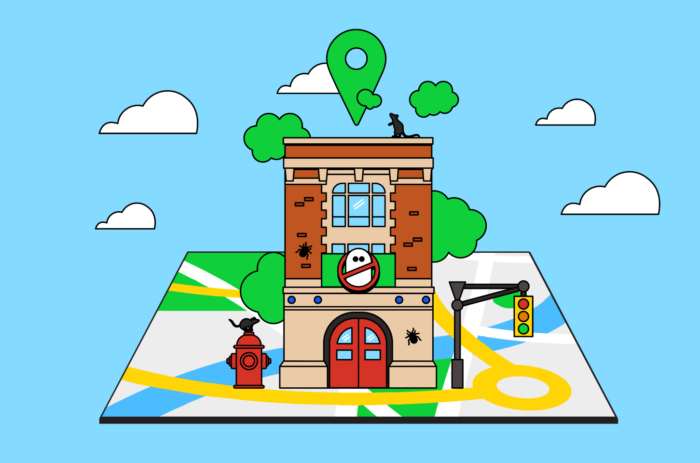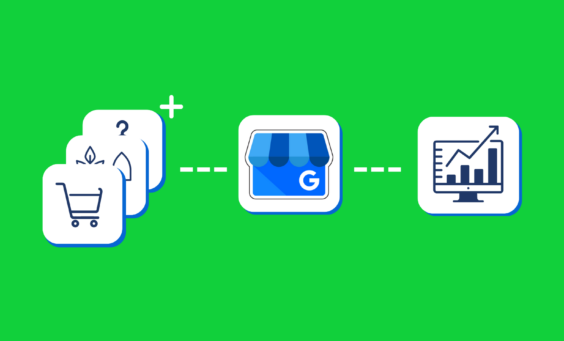Having a digital marketing strategy is already a given for most pest control companies. But we want to make sure you’re including local SEO in your lineup and doing it the right way. Many business owners or SEO specialists new to the local side of search will often get tripped up when developing their understanding of it.
This guide will offer a brief synopsis of what local SEO is and go over some best practices to get you started in the right direction.
Here’s what’s on the docket today:
- Why local SEO?
- Local SEO Basics
- Google Business Profile
- Website Optimizations
- Local Link Building
Why Local SEO?
SEO, in its most general sense, is all about meeting customers where they’re at. The goal is to develop steady visibility. Much like a restaurant trying to get on the corner of the best crossroads possible, SEO is the act of positioning yourself where there’s already high traffic to capture leads that already want your services.
In local SEO, the “crossroads” you’re looking for are the top positions of local-specific SERPs (search engine results pages), with Google Maps being your primary driver for lead generation.
So, why should you implement this kind of strategy? I won’t bore you with too many statistics, I believe it’s really easy to get lost in the data. To quote Mark Twain, “There are three kinds of lies: Lies, Damned Lies, and Statistics”. But I do have some numbers to give you a rough idea of what’s out there for the taking.
A homeowner, more often than not, isn’t checking the phonebook or physically looking around for a pest control company. They may ask friends for referrals, but even in that case, they’re likely still Googling it on their phone. And the number of people doing that increases every year. In fact, in 2019, local business searches on mobile increased by 250%.
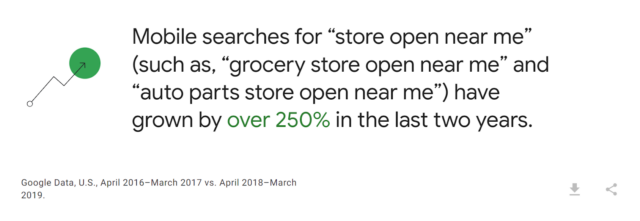
Considering Google processes about 5.9 million searches every minute (Statista, 2019), an increase like 250% is quite staggering. Additionally, about 46% of all Google searches have local intent. Almost half of 5.9 million searches a minute is a big slice of the pie. Let’s make sure you get a piece of it.
You might ask, would a paid ads campaign be enough? Those work for local searches, right? While I would certainly encourage you to get a paid ads campaign as well, this will only get you a portion of what you could have and it’ll cost you every time you get a lead. When we bring this to our clients, we tell them that the goal is to own as much real estate on the first page of Google as possible.
Consider this SERP for the query “pest control sacramento”:
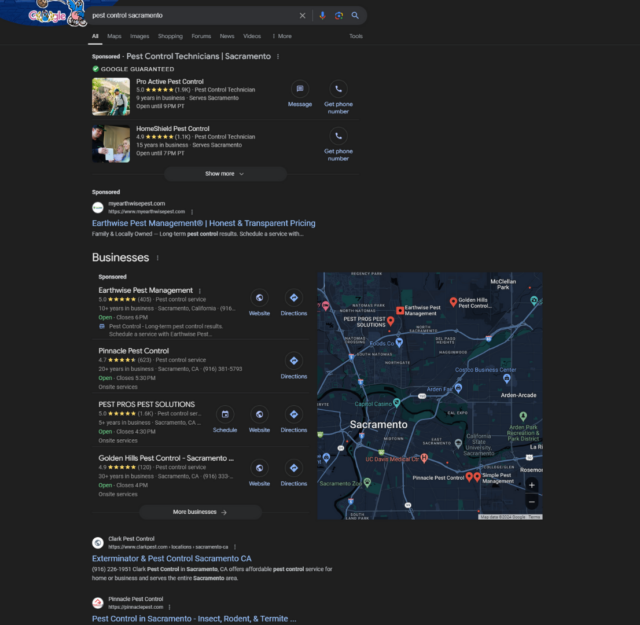
This is what the majority of queries with local intent will generate. On this SERP we see sponsored ads, Google Guaranteed ads (or Local Service Ads), a Local Pack for maps listings, and some locally relevant organic results. Claiming top rankings for the Local Pack and organic listings fall under SEO. That’s two of your four options. Why leave any of them behind?
Not everyone takes the time to invest in this kind of strategy. It’s certainly not uncommon, but investing in local SEO will give you a competitive edge over the competitors that neglect their online presence. When multiple pest control companies service the same area, those with a strong local SEO strategy are more likely to attract and retain customers.

Ready to improve your rankings? Talk to us about our Local SEO Services
Local SEO Basics
As explained earlier, we’re trying to position you on that “crossroads”. But how does that work exactly? For this section, we’ll be talking about the different types of SEO and the unique attributes and ranking factors that go into local SEO.
The difference between local and traditional SEO
When people think about SEO, they usually think about traditional SEO and Google’s traditional algorithm. They think about building a website and getting different pages to rank for different keywords. The core of that idea remains important to any form of SEO, but it’s important to understand that Google actually has multiple algorithms designed specifically for different industries.
Google knows the average consumer’s search habits differ depending on the product or service they’re looking for. To address that, Google has developed different algorithms to meet the needs of search intent. To see this in action, try looking up a service like “pest control services“ and then search for a product like “nike basketball shoes”. Take a look at how different your SERPs looks:
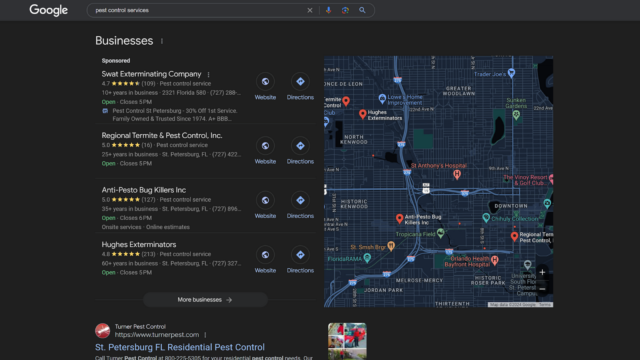
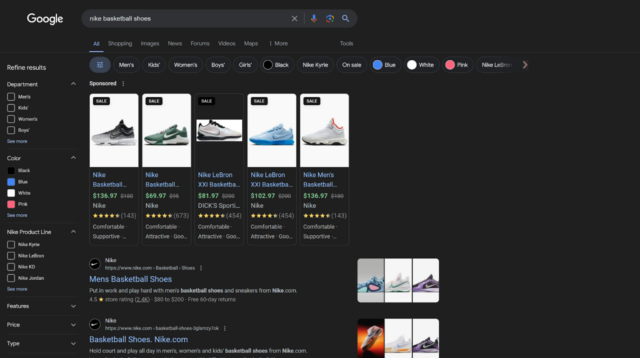
Very different results, right? The search intent behind each query triggered different algorithms. “pest control services” yielded results related to local service searches. Even the organic results below are localized organic results that wouldn’t show for another city. Meanwhile, “nike basketball shoes” yielded a SERP geared towards e-commerce. What makes you rank for one algorithm doesn’t necessarily succeed in another.
How these algorithms work exactly can get complicated. In fact, the most common answer to an SEO question you can get from any specialist is “It depends”. To make things even more fun, Google doesn’t tell us much about how they work. At least, not in detail. However, through a lot of expert testing, experience, and note-sharing, we do have a good idea of the different ranking factors that go into them.
Local Search Ranking Factors
Based on data from the 2023 Local Search Ranking Factors report from Whitespark, we have a general summary of what factors matter most to Google.
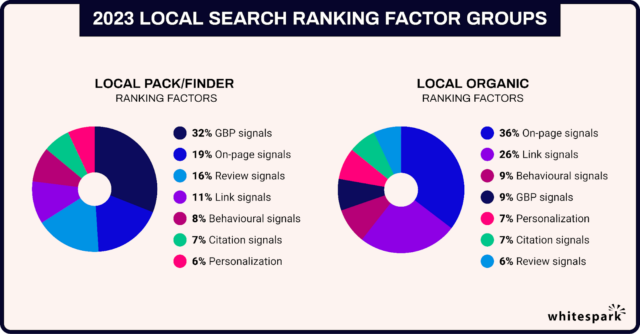
These percentages are aggregates of various specialists’ experiences and are full of important details and nuance.
It’s important to remember that no survey results will be perfect. For example, what works for someone else may not work the same for you. What works for you may change based on your specific location, local competition, or industry. It’s also important to note that these percentages don’t tell you how much time you can, or should, dedicate to them, nor how much you can influence each of them.
But this does give us a guideline for where to focus our efforts. Today, we’ll overview introductory strategies for some of the more important factors in local rankings.
Local Rankings
Ultimately we care about two things:
- The Local Pack/Google Maps
- Local Organic
You could also track rankings more specifically for things like Mobile and Local Finder as well. Rank tracking tools like BrightLocal’s Local Rank Tracker are great for those added details. But those are bonuses.
The Local Pack and Google Maps
The Local Pack, sometimes referred to as the Map Pack or 3 Pack, is that group of businesses that displays in search results for a query with local intent (just like that “pest control services” example we went over earlier). There are usually only three Google Maps listings here, but you may have a fourth if there’s a sponsored profile.
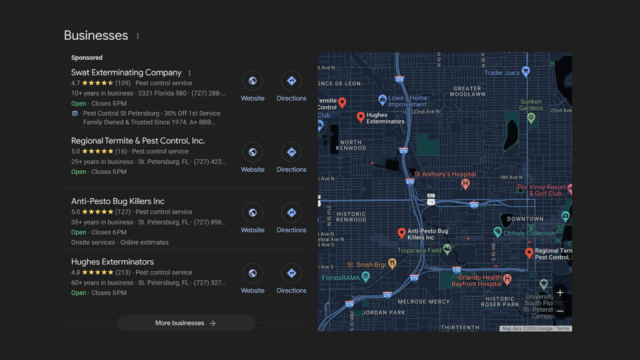
This is where we get the most leads, so our goal as local SEO providers is to get into the ‘top three’ on the Map Pack for the most visibility.
It’s important to note, though, that ranking top three in one part of the city doesn’t mean you rank that well throughout the whole city. You’ll need a tool to see your average map ranking for the region. I highly recommend using a tool like BrightLocal’s Local Search Grid tool. We use it every day.
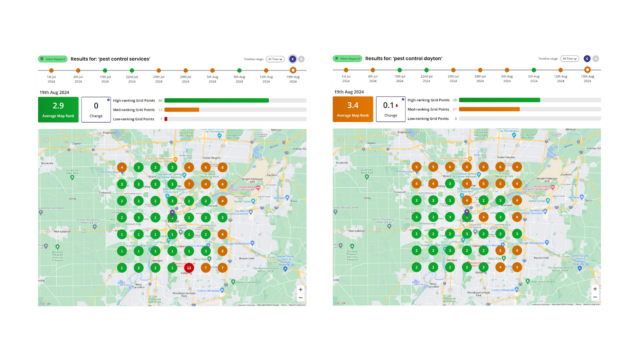
Local Organic
While map rankings are the most important focus, we still want to take care of local organic rankings. These are the standard results that are shown below the Map Pack. By comparison, they are more likely to be overlooked by the ready-to-hire decision-makers you’re looking for. But people do still look at them, and you want to capture those leads, too. What’s more, ranking well here can help you rank for the Map Pack.
And just like local map rankings, your location makes a difference. It’s not as drastic, but you still want to know what your organic rankings are locally. You’re going to want a tool like BrightLocal’s Local Rank Tracker to track them.
Google Business Profile
Those listings you see on Google Maps are called Google Business Profiles (GBP), previously known as Google My Business. A well-optimized GBP is the cornerstone of successful local SEO campaigns. It’s where the majority of pest control calls are made, and that makes it your most valuable asset in this strategy. Setting it up properly and knowing how to manage it is essential.
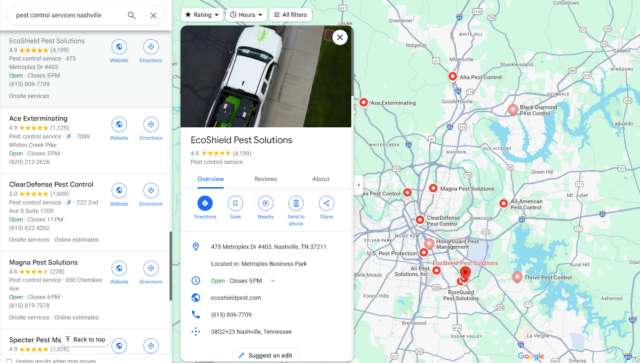
The GBP acts as your digital storefront. It’s the lit-up sign on a restaurant and the inviting ambiance that says “Come on in, the food’s great!”. It’s the first impression customers will have of you, so make it count.
In this section, we’ll go over the following:
- Staying organized
- Setup and verification
- Essential optimizations
- Suspensions
- Google Posts
Some of the optimizations we’ll discuss will be for rankings, but others serve better as a conversion factor. It’s important to get in front of a consumer, but of course, we want the sale even more.
Staying Organized
Setting up and managing GBPs can quickly become a serious headache if you don’t have a plan in place for staying organized. The two biggest things you can do for yourself will be:
- Determine the email(s) with which you will manage the profile(s).
- Establish a single source of information for you and your team to reference.
Email for Managing GBPs
The best approach, though not required, is to use a Gmail account with a domain-specific email. This will help you avoid headaches later down the road, such as what you might experience when appealing a suspension (we’ll touch on this later). Google wants to see these emails used the most, and I would recommend them as well.
If you manage multiple locations, it may be worth setting up an Agency Dashboard. The benefits of an Agency Dashboard may depend on the number of locations you will be managing, and they’re certainly not for everyone. You can learn more about them here.
Single Source of Information
There’s a host of reasons why you’d want a master list for your information. One example is that Google is notorious for repeatedly making edits to the profile’s services section (something we’ll revisit later in this guide). Having a list can make fixing that section less painful, especially if it’s a task you want to delegate to someone else. You also don’t want to find yourself in a situation where you or your team can’t remember the logins (more common than you’d think). Losing those may mean repeating the claiming process, which is simply no fun.
There’s no one way to set this up. It can be as simple as a spreadsheet and password manager or as demanding as developing software to meet these needs in tandem with others in your company. Whatever method you choose, just make sure you write everything down, and “future you” will thank you.
Setup and Verification
Now that you’re ready to get started, you’ll want to check if there is already a listing for your business on Google. If your business is already listed, you can request ownership. If not, you’ll need to build one. In either case, you’ll want to use the email you’ve chosen to manage your profile(s) and log in to business.google.com to begin the process.
Requesting Access
Once you’ve logged in, click “Add single business.” This should pull up a page like the one below. If you haven’t set one up before, you may be sent to this page automatically.
If your listing already exists, it should appear in the drop-down menu when you type in the business’s name.
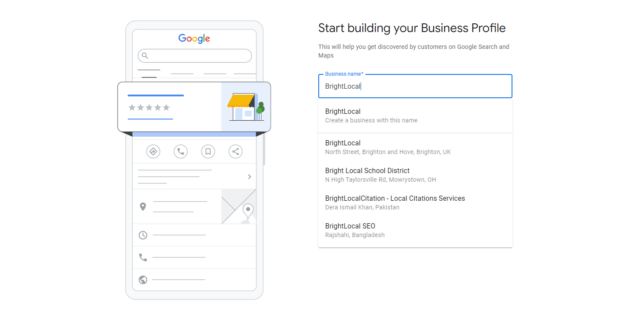
Sometimes, your business will exist on Maps but not show up in this drop-down. This is rare, but if this happens, you’ll want to claim it directly on Maps. To claim the listing here, find and click the link that says “Own this business?” It’s usually under the address section of the profile.
You will likely have to undergo some kind of verification. We’ll touch on some of this later.
Creating a New Profile
If you are building a new profile, you’ll use the same tool. But instead of selecting one of the existing options, you’ll simply select the one that says “Create a business with this name”. Make sure you put in the name of your business as it shows on your website or official documents. Keep it simple.
Primary Category
The primary category is one of the most important ranking factors for your GBP. There isn’t much you can do with it, but make sure you select the right one. Google wants to know who you are and what service or industry you identify with most before it decides what to do with you. Right now, it’s really easy for pest control. You’ll likely want to select “pest control service” as your primary category. Additional categories can be useful, but we’ll cover that later.
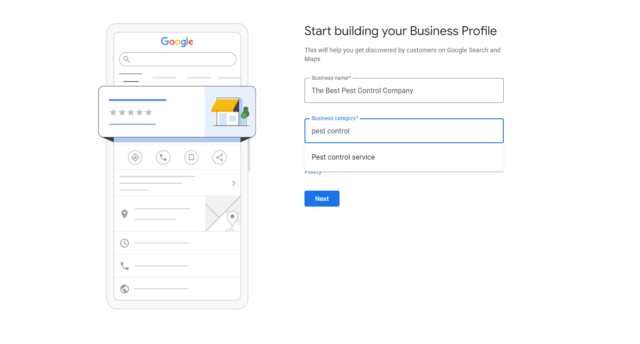
Physical Storefront or Service Area Business
The next thing Google will want to know is whether or not you have a physical location or if you service customers at their homes. Pest control companies may not have a physical location, and that’s fine. You can set up your GBP without an address and just add a service area. If you do have an office, though, then I recommend using it. Both work, but I usually counsel my clients to get a legitimate office. This may come with an upfront cost, but if you research your city properly, it’ll more than pay for itself over time.
It is worth noting that Google takes verifying the legitimacy of a location very seriously. They’ve created various barriers to entry to make sure people follow their guidelines. Many, including myself, would say Google can be a bit excessive in their approach. But trying too hard to game the system simply isn’t worth it. I strongly recommend you make sure you have a physical location for any GBP you create to avoid unnecessary headaches.
Verification
Getting verified may be as simple as entering your information, but you’ll most likely be required by Google to take an additional step or two to prove your legitimacy. Google will be the one to decide what options you’re allowed to use, and it won’t always be the same option.
Options you may be presented with include:
- Video
- Phone
- Postcard
Experiences with each verification type may vary. After some updates to the software a little ways back, it’s been my experience that video verification has been both the most effective and most likely option. In many cases when selecting the other options, it’s common to be asked for additional verification by video anyway. This is also the most demanding option, so I usually recommend my clients plan on this verification method.
Phone Number
While having multiple profiles with the same number isn’t unheard of, having a unique and local phone number for each profile is better. If you decide to do call tracking, the best practice is to enter the call tracking number as your primary phone number and the actual office number as an additional number. This way you can get the benefits of call tracking while still showing Google that you’re being consistent with the phone number on your website and your citations.
URL
Your choice of URL can affect both rankings and conversions. If you only have one location, the home page is usually the best URL to put in here. But if you have multiple locations, the best practice is to use a page specific to that location.
NAP
Your Name, Address, and Phone number (or NAP for short) should be consistent with your citations, so make sure your details are accurate. For example, the name of your business should match the name on your website.
Keyword stuffing is not advised. I can’t say I’m not tempted to do it, but Google has become quite aggressive about ensuring that doesn’t happen, and it can result in suspensions. It’s common for Google or even competing SEO specialists to scan batches of profiles at a time for this guideline violation, and suspensions just aren’t worth it.
Services
Use the Services section to make your offering as clear as possible. These don’t show on desktop, but they do on mobile, and that’s where many of the searches will be anyway. Add all your services and don’t forget to add individual descriptions. This can include the types of pests you cover, like ants or roaches, or more general offerings like home pest inspections or crawl space-related services.
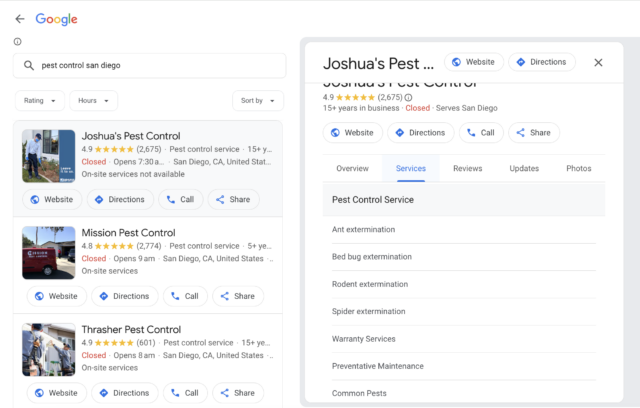
Also, note that Google loves to edit this section. You may like some of the changes but check them periodically to make sure they’re accurate and that Google hasn’t started overpromising anything.
Additional Categories
Additional categories are something I consider a “bonus” optimization. This is less useful for my pest control clients, as there are fewer viable options for their industry. However, your specific business model and service offering may change that. For example, companies that also offer “wildlife control services” can add that as an additional category.
Ultimately, the primary category is what’s really important, but it doesn’t hurt to add more when you can and when it’s relevant.
Opening Hours
Google gives users the ability to suggest edits to GBPs, and one of the most common uses of that feature is to edit inaccurate hours. Nothing is more frustrating to a potential customer than finding out a business isn’t actually open. It’s one of the more common motivations for leaving a bad review. Considering reviews are such a large ranking factor, accurate hours are important to your rankings as well, even if indirectly.
When your business is open can also affect your rankings. You’ll usually rank better when you’re open. There is a lot of research and heated discussion on this topic, so I recommend taking a look at some articles like this one from BrightLocal to learn more. The short version is that you should focus on the hours being accurate more than on trying to extend your opening hours on your GBP to get more rankings. It’s not going to help you; for example, if customers get angry, then suggest edits to your listing hours and leave bad reviews.
However, this doesn’t mean you can’t find a way to use this to your advantage. A boring solution, but an effective one, would be to extend your operating hours a bit. It doesn’t always have to be about being clever. This may have some implications for your operations, but it’s certainly an option. You could also try having a call center available 24hrs. Currently, this isn’t an option for additional hours, though I’ve never understood why. Your office may be closed, but maybe you’re still available to help your customers in other ways. This approach doesn’t always work out, so you’ll have to test things for yourself. But don’t assume too much about what you can and cannot do. Think outside the box a little.
Photos
It’s good to have some official, professional photos that show your team at work, your office, or aspects of your service. Even better than that is getting photos from customers, and doing so consistently. This can increase conversions in a similar way to Google Posts and can bring engagement signals to boot. There are some guidelines and best practices you’ll need to keep in mind though:
- Screenshots, stock photos, GIFs, other manually created imagery, or imagery taken by other parties should not be uploaded.
- To be relevant, photos or videos must be taken by users at the location in question.
- If the primary subject of the content is irrelevant to the location, it may be removed.
- Stylistic adjustments (such as applied filters) are acceptable, provided that these stylistic changes are minimal and aren’t appended elements such as borders, text, collaged images, etc.
- Content that makes it difficult for others to understand the environment that you’re sharing may be rejected. Examples are excessively dark or blurry images, significantly rotated compositions, and images that use filters to dramatically alter the representation of the place.
- Images must be of a sufficient resolution. The exact requirements may vary by photo type and point of upload.
- For 360° photos, superimposed content must be limited to either the zenith or nadir (top or bottom 25% of the equirectangular image), but can’t be present in both.
- For traditional digital photos and videos, superimposed content can’t take up more than 10% of the image or video, and must be limited to a single edge.
- Superimposed text or graphics must be relevant.
- Distracting superimposed text or graphics aren’t permitted.
Essentially, Google wants these images to give people a good idea of what they’re getting themselves into. To illustrate this idea, I usually give my clients the example of getting a dentist recommendation from a friend. What would you hope to find when you look up their listing for the first time? You’d want to see images of the front desk and lobby area, images of the employees at work, and any other image that builds your trust in the business’s quality and gives you the confidence to know you’re in the right office when you get there.
The same goes for pest control. Some examples you can use include pictures of:
- Technicians at work
- Customers talking with your technician
- Your office, including the entrance, lobby, etc.
- Branded truck or van
- Photos of pests you provide services for
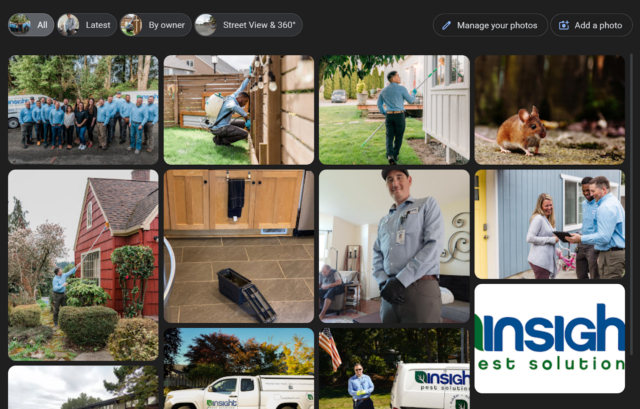
Suspensions
I’ve said it before, and I’ll say it again. The GBP is your most valuable asset in a local SEO strategy. Losing a GBP to something like a suspension can have major ramifications for lead volume. It’s the last thing you want, but you should be prepared just in case.
It’s important to take a preventive approach, but nobody is immune to suspension so it is equally important to be prepared for when it does happen. In fact, it happens to 35% of GBP’s every year. And it’s not always because of a direct violation. In any case, you want to be ready to make an appeal should the need arise.
Appeals
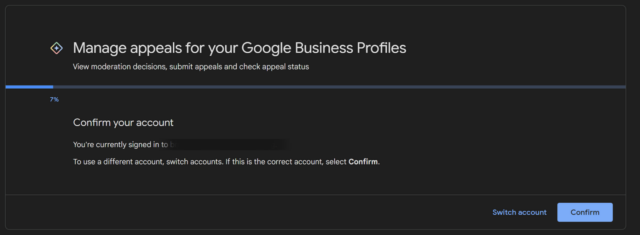
As of the most recent software update, you only get two attempts at appeals. To make matters more stressful, the process is timed. Once you begin the appeals process, you will have 60 minutes to upload two or more of the following:
- Official Business Registration
- Business license
- Tax certificate
- Utility bill
It’s critical that the business name and address are exactly the same on all documents and your GBP. I would also strongly advise you to gather these documents long before a suspension happens. Appeals and verifications can be quick, but sometimes they can take weeks or even months in more extreme cases to remedy. That’s a long time to go without calls. You want to mitigate risk as much as possible, and the best approach is to prepare ahead of time.
I’m a little biased, but I would also highly recommend having a specialist help you through the appeals process if you can. Especially if it’s for multiple locations. There are a lot of innocent mistakes that can be made in this process and honestly, the software seems to have a new bug every update. Having a specialist on hand can help you avoid common pitfalls and give you the perspective needed to chart a course through any uncharted waters that may present themselves.
To learn more about GBP suspensions, you can read this article by Ben Fisher.
Google Posts
Google Posts are those little posts with images and text at the bottom of a GBP. It’s a tool you should absolutely be using if you have the time, but note that posts don’t really serve you as a ranking factor. This one’s more beneficial for customers and conversions than for the algorithm.
I like to think of it as a backstop. Anyone scrolling through your profile who has yet to click the call button or open your website but who hasn’t left either may still be a prime lead. They might just be a little on the fence. Having a post there with a good image to catch their eye and a good offer to nudge them over the decision-making ledge can help you capture leads you may have otherwise lost.
Website Optimizations
The GBP may be your new home page, but your website is still important. After all, conversions/sales will happen there too. As for rankings, on-page signals are a major ranking factor for both the Local Pack and Local Organic.
For this section, we’ll be going over:
- Technical SEO Checklist
- Content Strategy
Technical
As long as someone on your team is a web development specialist, this is low-hanging fruit. This may differ in other verticals, but in local SEO, it really comes down to following a simple checklist of key qualifications that Google is looking for in a website. I like to think of it as building a resume properly. The content matters most, but structuring it well is what gets the interviewer reading.
Google wants to make sure the best content makes it to its users, and measuring user experience is just as important to them as analyzing your content.
This checklist isn’t everything, nor all the various ways you could utilize them. The SEO mantra “it depends” always applies. But as long as you hit these points, you’ll be in a good spot.
Important: When you’re doing technical SEO, make sure that you check your mobile responsiveness, not just desktop responsiveness. It’s a common mistake even relatively experienced specialists make sometimes. Image optimization, for example, may need to be done differently on mobile than on desktop.
Core Web Vitals
Core Web Vitals are metrics Google uses to measure the real-world user experience of a web page. You can check a variety of different metrics on Pagespeed Insights, but the three most important are the following:
- Largest Contentful Paint (LCP): This measures loading performance. To provide a good user experience, LCP should occur within 2.5 seconds of when the page first starts loading.
- Interaction to Next Paint (INP): This measures interactivity. To provide a good user experience, pages should have an INP of 200 milliseconds or less.
- Cumulative Layout Shift (CLS): This measures visual stability. To provide a good user experience, pages should maintain a CLS of 0.1. or less.
Image Optimization
Images that are too heavy can easily slow down your site. Using a lighter and more modern format like .webp is ideal, but using minimal-quality images that don’t sacrifice the visual experience will be a good place to start if you’re using .jpeg or .png formats.
Image Alt Text
It doesn’t hurt to add keywords, but making it “make sense” is infinitely more important. Alt text allows tools like screen readers to describe the image to visually impaired users, ensuring they can understand the content of the page.
Headers
Keep it to one H1 header, not multiple, and ensure it’s optimized for keywords. After that, it’s good to use keywords or variations of it in your other headers.
Javascript Reduction
Javascript can be pretty heavy and hinder your page speed. This doesn’t mean you can’t have Javascript or that it’s going to be the end of the world. But don’t use it unnecessarily. You should try to reduce it where you can.
URL Structure (Slug)
Google and its users like it when you have clean and clear URL slugs. The goal here is to keep it short, descriptive, and helpful. Keyword rich is great, but simplicity and clarity are most important. Ask yourself “Would I know what the page was about just by reading the URL?” Some good examples can include something like /pest-control-savannah or /locations/savannah-pest-control.
Meta Data
If you’ve done SEO in the past or done any research on it, you’ve probably heard of this already. Super basic, but don’t ignore it. Similar to URL structure, you want things to be clear and helpful. Do this for the Meta Title and Description, and make it unique. Keyword usage is great, but again simplicity is key.
XML Sitemap Submission
Submitting an XML sitemap to Google Search Console helps speed up the indexing process and helps the crawlers better understand how your site works. Really, the primary goal of much technical SEO is just guiding the crawlers—simplifying their job, as it were. This does just that.
Redirects
Managing redirects ensures a seamless user experience and prevents search engines from wasting resources on broken links. Implementing correct redirects ensures users don’t end up on a page with outdated information or similar.
Content Strategy
There are a lot of aspects to good content strategy, especially if you want to get into things like topical clustering or content silos. To keep it simple today, we’re going to talk about some guiding principles and give you an example of a structure you can use on a location-specific page (the page whose URL you should be using on the GBP, as we mentioned earlier).
What kind of content ranks?
“Content is king” is a phrase that’s thrown around in the SEO community almost as often as “it depends”. And there’s truth to that. But far too many people seem to take that to mean “more is better”, and that’s simply not the case. While I won’t say it’s “quality, not quantity” we can confidently say it is “quality over quantity.”
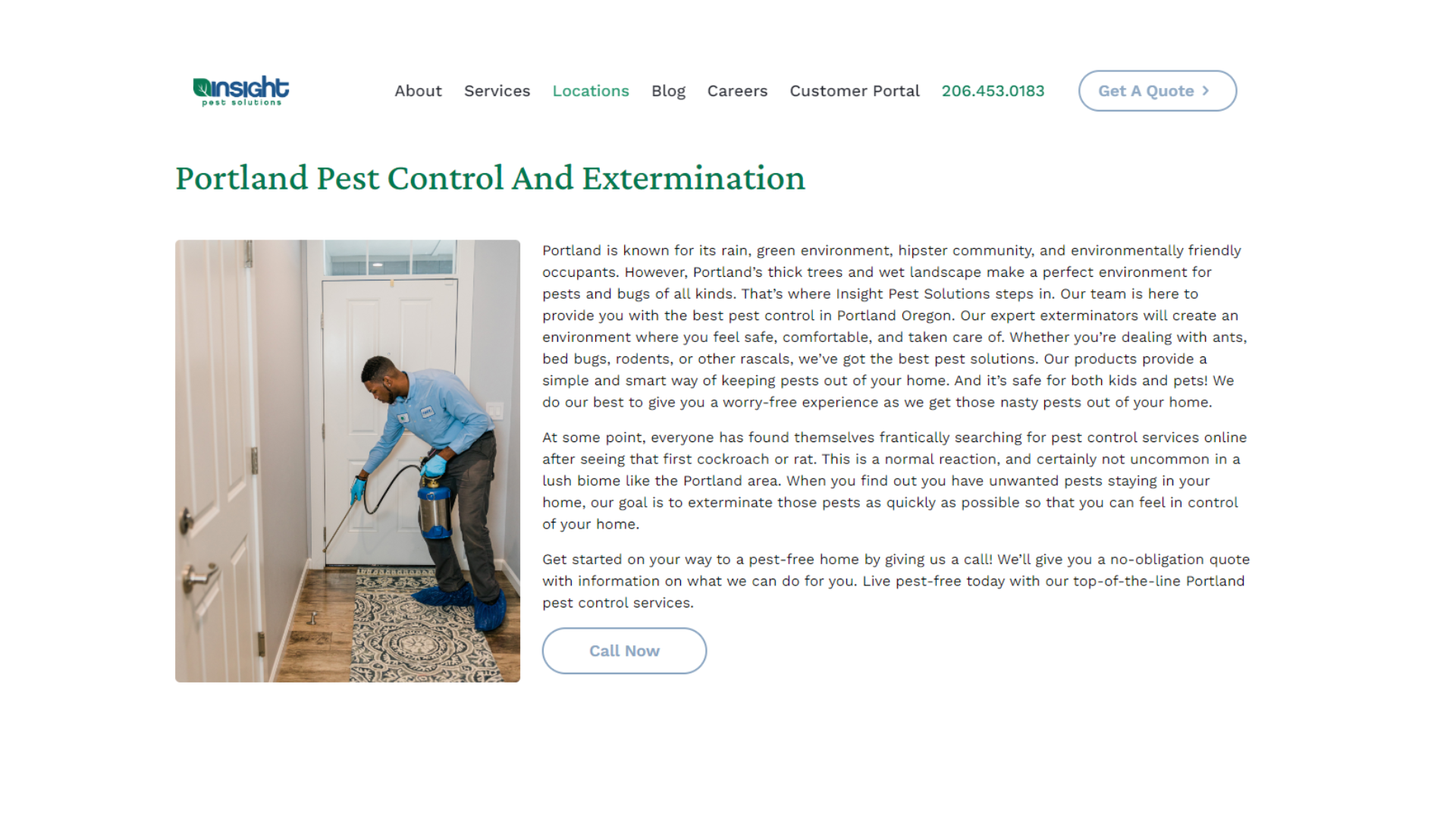
It all depends on search intent. The kind of content someone is looking for on a Wikipedia or WebMD page is not the same type of content someone is looking for in a pest control company, bank, or restaurant. Even those last three examples, despite all being under the umbrella of local SEO, wouldn’t be evaluated the same by Google. Especially not once it takes behavioral signals into account. Your primary goal should be to help customers based on search intent. In a strategy for pest control, you should be focusing primarily on serving customers at the bottom of the marketing funnel. Think decision makers, not researchers.
I like to think about my experience as a door-to-door sales representative when I teach my team about this.
Years back, when I was knocking on doors and learning how to convince people to sign a service agreement with me, one of the biggest obstacles I had to overcome was my brevity (still working on that, if we’re being honest).
People who were actually going to turn into a sale may have one or two questions or objections to resolve, but they’re not looking to go down a rabbit hole to learn everything there is to know about my offering and the topic of pest control. They don’t need to hear me ramble until their eyes glaze over, they need to make a decision. They just need to know if I offer what they need and if they can trust me.
This doesn’t mean all of my pitches were two minutes, but the average time I spent at the door lessened as my pitch improved. More importantly, I learned from painful experience that the ones who were still looking to go that deep into the weeds were usually not going to buy or would cancel over the phone later anyway.
Your approach should mimic what sales reps such as myself strived for in a good pitch. Keep it concise and always be selling (we’ll address call-to-actions later). Again, this doesn’t necessarily mean short. But it should be deliberate and no longer than necessary.
It’s also worth noting that this is important for conversions, not just rankings. You want people to actually buy from you, not just see your website. And that’s hard to do with thin content.
E-E-A-T
E-E-A-T is Google’s acronym for Experience, Expertise, Authoritativeness, and Trustworthiness. This is what Google looks for in our content, and it also illustrates their goals for the future methods of measurement they want to develop.
If you don’t get too caught up in the weeds and focus on demonstrating these principles (even in the more technical aspects of your approach), you will not only rank well now but continue to rank well even after aggressive algorithm updates that upend other strategies that dismiss this.
Location Page Anatomy
There are a lot of things you can do to vary this, but good locations pages should, at minimum, include:
- NAP Section
- A section for other locations
- CTAs
- Unique Content (approx. 40% or more)
NAP Section
Have a section on your page that looks like a listing with your name, address, phone, and a GBP map-embed. You can pull the embed code directly from Google Maps by clicking “Share” and selecting the “Embed a map” tab.
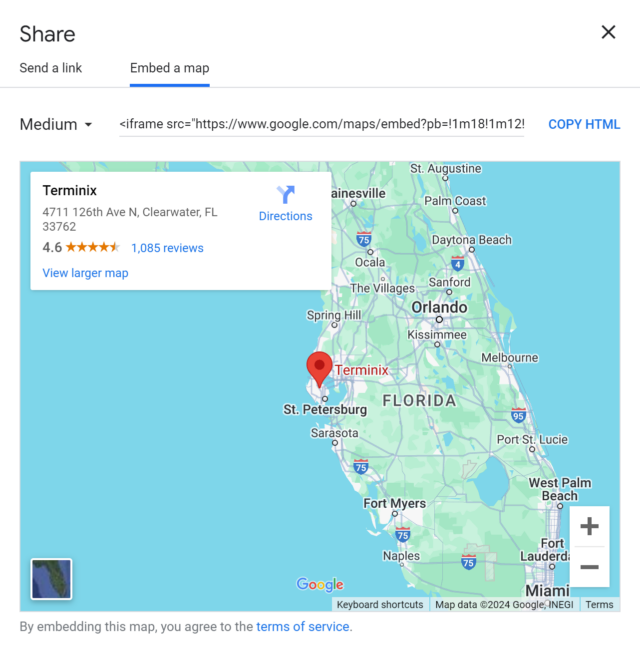
Other Locations
It’s best practice to have a section connecting this location page to others. Think of the customer journey here: If a decision maker isn’t certain the location they’re currently looking at is close enough for their purposes, you can catch them before they lose interest by taking them to another location page.
CTAs
When I was still selling, “always be selling” was my equivalent of the SEO mantra “it depends.” It was our catchphrase and calling card. This principle had nothing to do with being overbearing, obnoxious, or repetitive. Instead, it meant that we should keep the discussion on topic and prevent the conversation from wandering too far down the wrong path. The end goal was to help them make a decision.
In SEO, we do this with calls to action (CTAs). Make sure you have multiple sections with some form of a call to action. It can be as simple as a link to a phone number or as eye-catching as a section specifically for form fills. Just make sure you’re “always selling.” Just like the sales pitch, don’t overdo it, but don’t be timid about it either.
You can get creative with it, too. There is no need to always be overly formal. After all, you are appealing to humans. Using a CTA like “Book Appointment” is fine, but shake it up once in a while with phrases like “Evict Unwanted Pests,” like the one shown below.
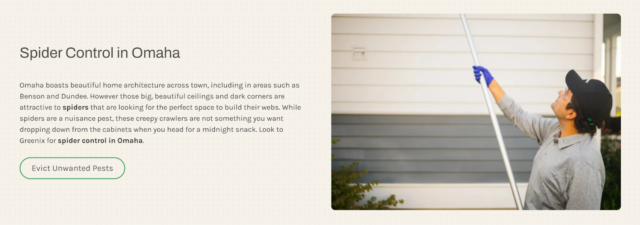
Unique Content
Having duplicate content on some pages is to be expected when building location pages. In theory, you should have multiple location pages, and it only makes sense that they’d share things in common. But simply duplicating it without variation provides little value in the eyes of Google and the user.
Right now, the accepted best practice for unique content is about 40-60%. This is a general rule of thumb, and it definitely depends on the specific circumstance, but it is a fairly safe range to start with.
One of the easiest ways to keep things unique, and with a little less effort to boot, is to write some location-specific content. Done right, this creates some differentiation between your pages while also adding some additional localized relevance.
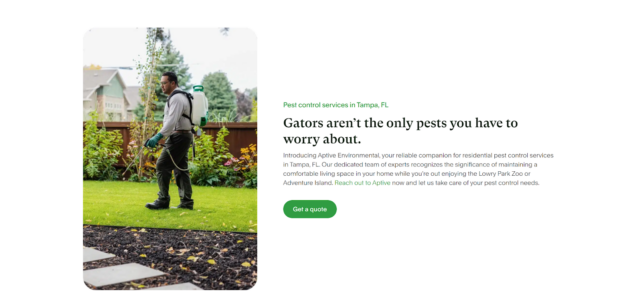
You can do this in several different ways, but making it feel personalized like the example above is one of my favorite approaches because it helps conversions, not just rankings. Conversions are about people, and purchases are ultimately emotional decisions. Making your company feel more authentic and personable draws customers just a little further down the path to conversion.
Local Link Building
Link building is a cornerstone of SEO. In fact, links are what gave Google an edge over their competitors in the earlier days of search. Before links, search engines relied on basic keyword matching, which very often led to irrelevant results that weren’t authoritative. If you’re curious about what that was like back in the day, give Bing a try (I’m kidding of course… kinda).
Backlinks would act as votes of confidence from one website to another. PageRank, the algorithm they used to implement this, revolutionized search engines by analyzing the quantity and quality of backlinks to determine a website’s importance. The more high-quality backlinks a website had, the higher its PageRank score and the better its position in search results.
It’s become much more complex than that in years since, but the function of linking remains important to SEO today. Like other aspects of SEO, how you approach it differs from vertical to vertical, city to city, circumstance to circumstance, etc. To make matters more confusing, it’s a topic I’ve seen debated amongst SEO’s more than most topics in our industry. The best advice I can give is this: Focus on what the link is accomplishing and be cautious of shiny object syndrome.
I would focus on two main aspects:
- What type of relevance are you lacking when you look at your rankings?
- How does the link you’re building help a potential user who comes across this link?
Whatever specific tactic you consider implementing, these guiding questions will help keep you from falling for shiny object syndrome.
Here are some options to consider, along with some commonly accepted practices:
Types of local link building:
- Content Marketing: Creating high-quality, informative, and shareable content can naturally attract backlinks from other websites. In the pest control industry, this would be best accomplished via quality blogs.
- Guest Posting: Contributing articles to other websites in your industry can establish you as an authority and earn valuable backlinks. This is one of the most common examples and is often viewed as Ol’ Reliable.
- Citations: Consistent NAP (Name, Address, Phone number) information across various online directories is essential.
- Community Involvement: Participate in local events, sponsor community initiatives, and build relationships. You should be able to ask them to get links to you on their sites.
Link-building best practices:
- Focus on quality over quantity: Prioritize backlinks from reputable and relevant websites.
- Diversify your link profile: Build links from various sources to avoid penalties.
- Monitor your link profile: Regularly check for any toxic or spammy backlinks.
- Build relationships: Networking with other local businesses can lead to valuable link-building opportunities.
Conclusion
The path to a well-executed local SEO campaign is hardly a straightforward one. This guide we’ve provided will get you pointed in the right direction. But you’ll need to spend a generous amount of time developing your skills to really gain and maintain a competitive edge. There is a tremendous amount of complexity in SEO, and the frequency of algorithm updates seems to grow exponentially every year.
The simplest course, which I would biasedly recommend, would be to hire a specialist who offers local SEO services. We dedicate all our time to testing, developing expertise, and staying at the head of the curve. That’s the experience you want working for you, not your competitors. But if that’s not the route you choose, I recommend dedicating regular amounts of time to research. Learn accepted best practices and stay up-to-date on the latest search engine algorithm updates. Spend time learning from the various specialists that are out there. Do this, and with time you can transform your pest control business from a local player to a dominant force in your market.
